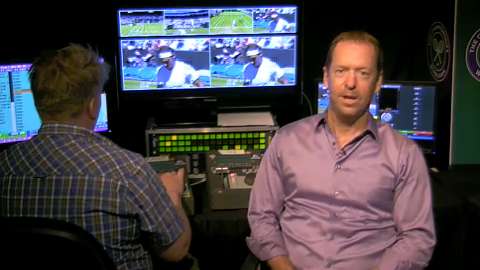They get nervous before a big match. They read every point instinctively. They are notable for phenomenal accuracy and speed of reactions. And they don’t have the luxury of wiping their brow with a towel between points.
The 48 members of IBM’s data capture team are the unsung heroes of The Championships, poised courtside to input an extraordinary amount of information about every single point played.
See if you've got what it takes to be on IBM's data capture team.
In a matter of micro-seconds their info collection goes ‘live’ in the form of an updated score and data for wimbledon.com.
Of course nerves come into play, but that's good
Their role is vital in the presentation of tennis as a sport, but also in enhancing performance levels. At the end of a match, each player receives a report and a point-by-point trail to analyse their winners and errors.
Players on the Show Courts are given a USB key containing their match stats, though every player and coach can request one. When the difference between a winner and a loser can often be a matter of points, such data is crucial for player development and planning how to counter the next opponent.
The majority of data capturers are students who play a good standard of tennis. They know the shot definitions and lingo. They don’t have to pause to wonder if that really was a half-volley.
They don't get fazed when a player challenges a line call. Or when the data they input potentially marks a new entry in the record books. Even so, training is thorough, running from March to June and includes live rehearsal days.
Take the opening point of a match. Just one teeny weeny little point, but these are the questions that have to be answered: Where does the serve go (wide, into the body, down the centre, into the net)? Ditto, for second serve if required. Is the return a forehand, backhand, pass, approach, drop, lob, in, a winner, an unforced or forced error?
Who wins the point? How did the point finish? With a forehand or backhand, a drive, volley, smash, pass, approach, lob, drop, winner or unforced or forced error? Where were both players positioned? A at net, B at net, both at net, at the baseline or pursuing a serve and volley strategy? What was the rally count? The point score? And the game score?
When you consider there are on average 60 points per set and four to five shots per point, it is no wonder each courtside data bod works to a rhythm of two hours on, 40 minutes off, throughout a day where play can go on until 9pm.
Imagine being allocated Lleyton Hewitt’s first-round match on Day 1!
If all the courts are in action, there are 38 members of the data entry team working at any one time. Centre Court and No 1 Court have four: a verbal expert, who describes what’s happening shot by shot; a data inputter; a radar gun operator to record the speed of serve, and a shadow, watching it live, on audio link to the other three, in case of a challenge. If the network goes down, each court turns to ‘tick sheets’... old-fashioned pen and paper, just in case.
“Of course nerves come into play, but that’s good,” says Jessica Weeks, who recruits and manages the team. “It’s all about adrenalin and reaction.”
To get a flavour of the concentration and cognitive processing skills required, check out www.maketheteam.co.uk







































